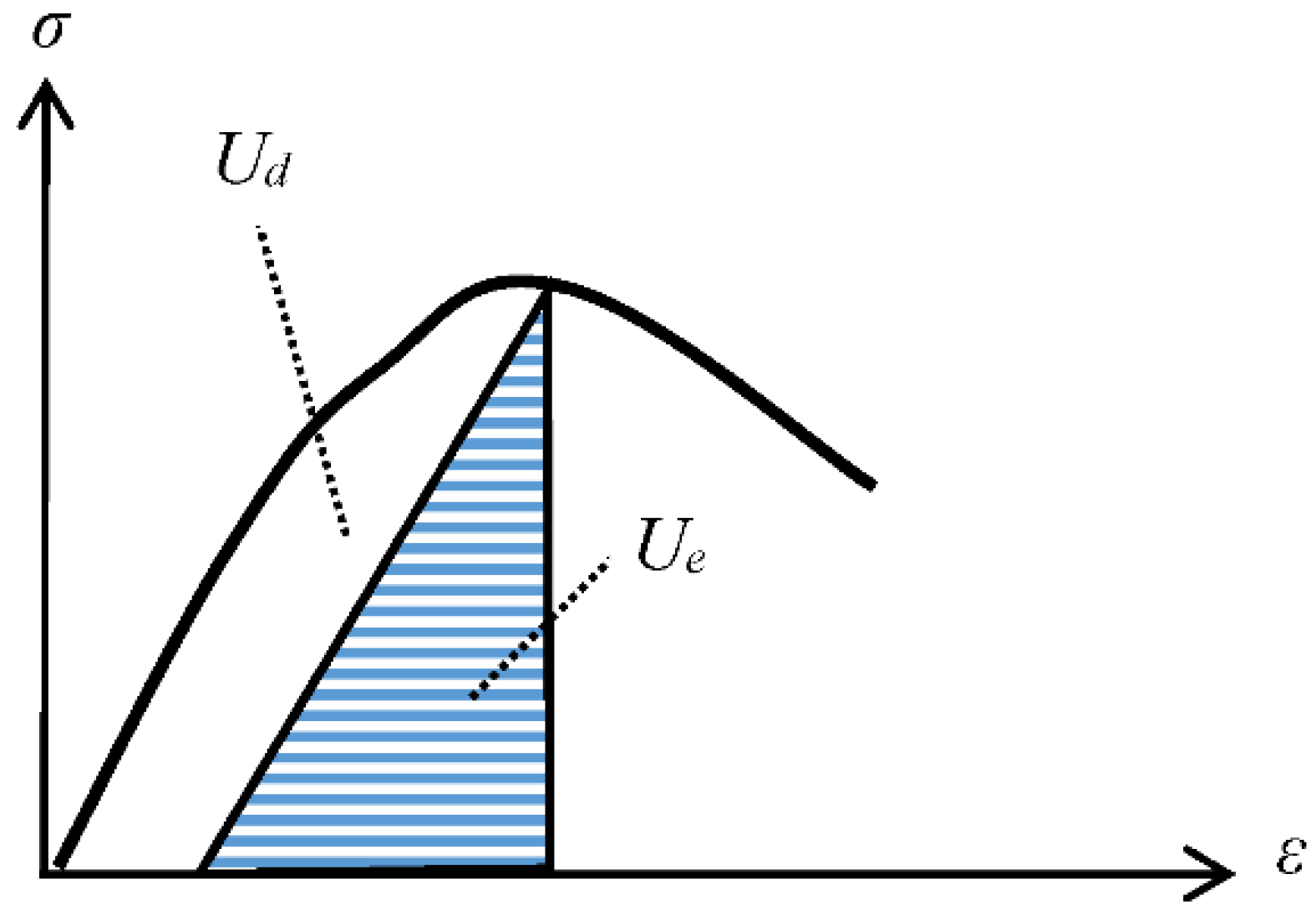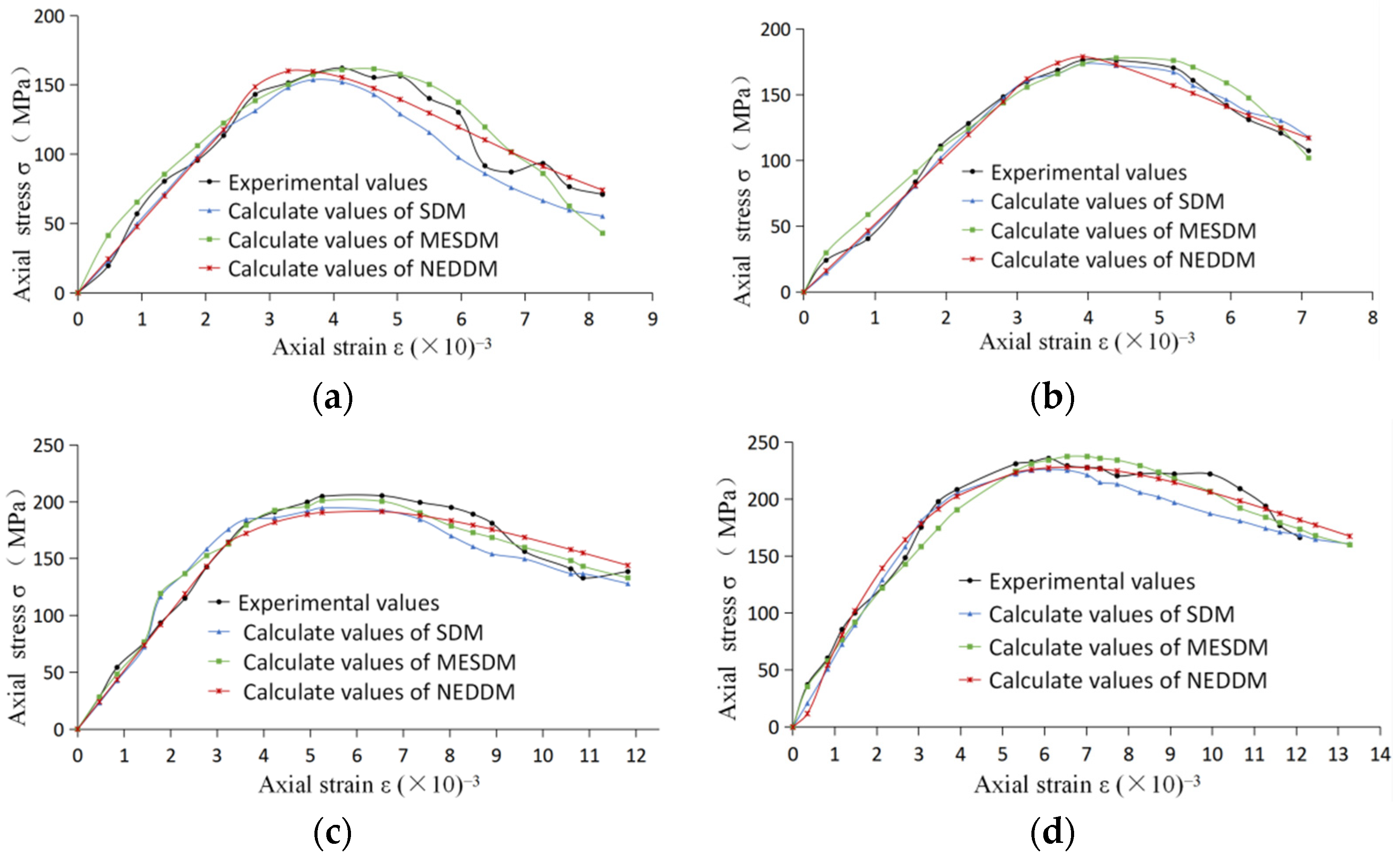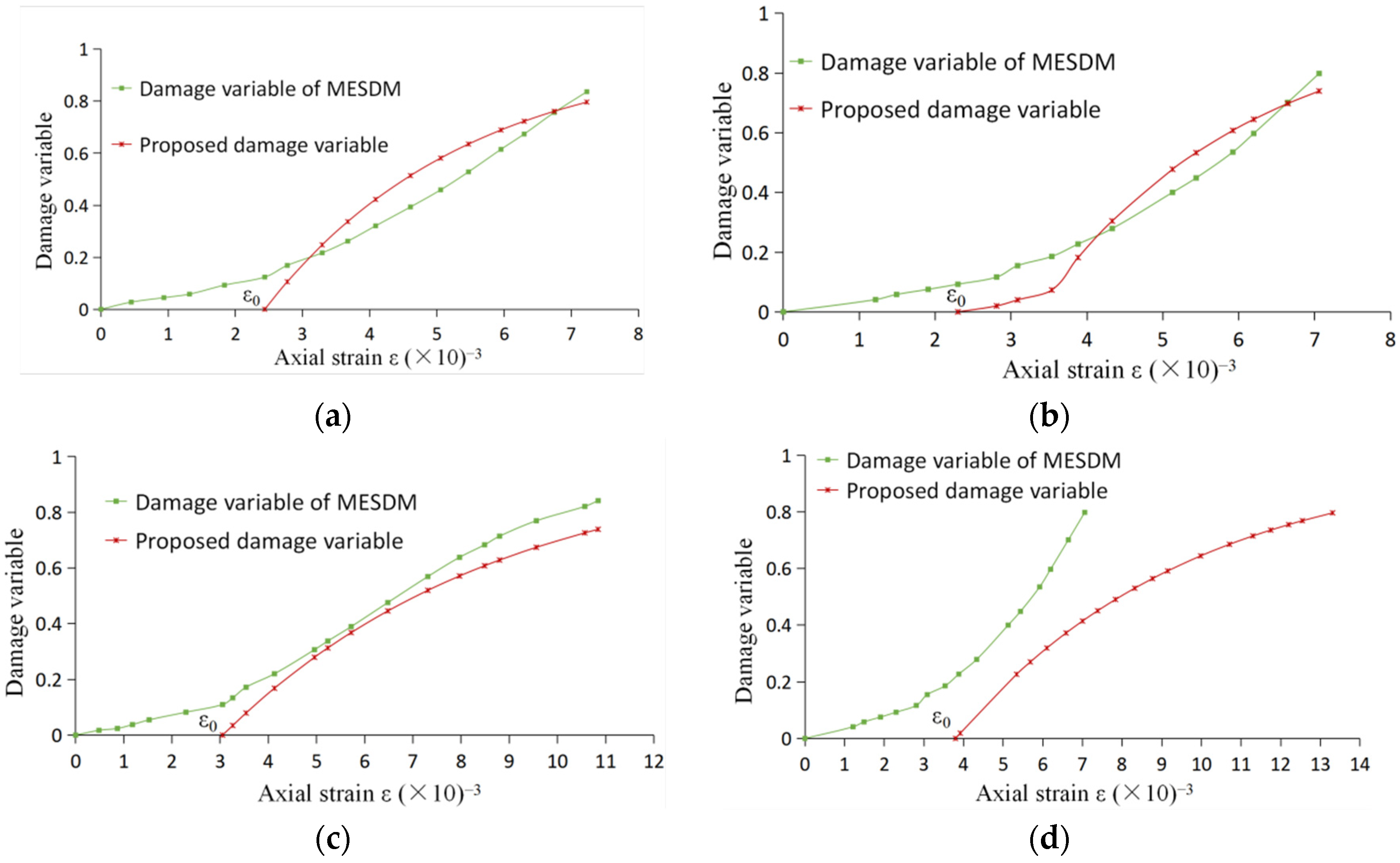Damage Evolution Modelling for Rock Materials Based on the Principle of Least Energy Dissipation Rate within Irreversible Thermodynamics
Abstract
:1. Introduction
2. Damage Evolution
2.1. Theoretical Framework
2.2. Damage Variable
2.3. Damage Threshold and Parameter Determination
2.4. Damage Energy Release Rate
3. Validation of Damage Constitutive Model
3.1. Application in Granite
3.2. Application in Marble
4. Conclusions
- (1)
- In irreversible thermodynamics, the damage variable with a simple form is derived by the least energy dissipation rate principle. By introducing the proposed damage variable into the free Helmholtz energy as an internal variable, the equivalence relationship between the energy dissipation rate and the damage energy release rate was proved by the second principle of thermodynamics. The rigorous thermodynamic theory was the cornerstone of this research. The proposed damage evolution method can represent the energy dissipation of rock during the deformation and has good universality.
- (2)
- Through the simulations of the stress-strain relationship of granite and marble, the calculated values obtained by the proposed model were close to the experimental values, and the fitting accuracy was slightly higher than other current models. The proposed model is applicable if the stress-strain relationship is simulated before the stress peak or the whole process. Parameter calculation is more convenient and concise.
- (3)
- The relationship between the new damage variable and strain was calculated, summarized, and compared with the current statistical damage variable. The results show that the evolution trends of the two were the same, but the former could give the critical value between elastic and plastic strain, while the latter could not. Energy dissipation is the first principle directly related to damage. The strain damage threshold obtained through rigorous deduction is more scientific and reasonable than the artificial assumed damage threshold.
- (4)
- This paper mainly focused on the theoretical damage evolution method and only applied to isotropic damage. Furthermore, verification of other rocks’ mechanical damage evolution characteristics is required. Future research should integrate the suggested damage evolution into the numerical simulation.
Author Contributions
Funding
Institutional Review Board Statement
Informed Consent Statement
Data Availability Statement
Conflicts of Interest
References
- Cook, N.G.W. The failure of rock. Int. J. Rock Mech. Min. Sci. 1965, 2, 389–403. [Google Scholar] [CrossRef]
- Dragon, A.; Mróz, Z. A continuum model for plastic-brittle behaviour of rock and concrete. Int. J. Eng. Sci. 1979, 17, 121–137. [Google Scholar] [CrossRef]
- Fredrich, J.T.; Evans, B.; Wong, T.F. Micromechanics of the brittle to plastic transition in Carrara marble. J. Geophys. Res. 1989, 94, 4129–4145. [Google Scholar] [CrossRef]
- Brady, B.H.G.; Brown, E.T. Rock Mechanics for Underground Mining; Chapman and Hall: London, UK, 1993. [Google Scholar]
- Fang, Z.; Harrison, J.P. Application of a local degradation model to the analysis of brittle fracture of laboratory scale rock specimens under triaxial conditins. Int. J. Rock Mech. Min. Sci. 2002, 39, 459–476. [Google Scholar] [CrossRef]
- Cai, M.; Kaiser, P.K.; Tasaka, Y.; Minami, M. Determination of residual strength parameters of jointed rock masses using the GSI system. Int. J. Rock Mech. Min. Sci. 2017, 44, 247–265. [Google Scholar] [CrossRef]
- Celik, M.Y.; Akbulut, H.; Ergul, A. Water absorption process effect on strength of Ayazini tuff, such as the uniaxial compressive strength (UCS), flflexural strength and freeze and thaw effect. Environ. Earth Sci. 2014, 71, 4247–4259. [Google Scholar] [CrossRef]
- Zhang, C.; Feng, X.T.; Zhou, H.; Qiu, S.; Yang, Y. Rock mass damage inducedby rockbursts occurring on tunnel floors: A case study of two tunnels at the Jinping II Hydropower Station. Enviro. Earth Sci. 2014, 71, 441–450. [Google Scholar] [CrossRef]
- Zhou, C.Y.; Zhu, F.X. An elasto-plastic damage constitutive model with double yield surfaces for saturated soft rock. Int. J. Rock Mech. Min. Sci. 2010, 47, 385–395. [Google Scholar] [CrossRef]
- Unteregger, D.; Fuchs, B.; Hofstetter, G. A damage plasticity model for different types of intact rock. Int. J. Rock Mech. Min. Sci. 2015, 80, 402–411. [Google Scholar] [CrossRef]
- Zhang, J.C.; Xu, W.Y.; Wang, H.L.; Wang, R.B.; Meng, Q.X.; Du, S.W. A coupled elastoplastic damage model for brittle rocks and its application in modelling underground excavation. Int. J. Rock Mech. Min. Sci. 2016, 84, 130–141. [Google Scholar] [CrossRef]
- Zhao, L.Y.; Zhu, Q.Z.; Xu, W.Y.; Dai, F.; Shao, J.F. A unified micromechancs-based damage model for instantaneous and time-dependent behaviors of brittle rocks. Rock Mech. Rock Eng. 2016, 84, 187–196. [Google Scholar] [CrossRef]
- Zhu, Y.P. A micromechanics-based damage constitutive model of porous rocks. Int. J. Rock. Mech. Min. Sci. 2017, 91, 1–6. [Google Scholar] [CrossRef]
- Krajcinovic, D.; Silva, M.A.D. Statistical aspects of the continuous damage theory. Int. J. Solids Struct. 1982, 18, 551–562. [Google Scholar] [CrossRef]
- Todinov, M.T. Is Weibull distribution the correct model for predicting probability of failure initiated by non-interacting flflaws? Int. J. Solids Struct. 2009, 46, 887–901. [Google Scholar] [CrossRef] [Green Version]
- Li, X.; Cao, W.G.; Su, Y.H. A statistical damage constitutive model for softening behavior of rocks. Eng. Geol. 2012, 143, 1–17. [Google Scholar] [CrossRef]
- Li, C.B.; Xie, L.Z.; Ren, L.; Wang, J. Progressive failure constitutive model for softening behavior of rocks based on maximum entropy theory. Environ. Earth Sci. 2015, 73, 5905–5915. [Google Scholar] [CrossRef]
- Zhao, H.; Shi, C.J.; Zhao, M.H.; Li, X.B. Statistical damage constitutive model for rocks considering residual strength. Int. J. Geomech. 2017, 17, 04016033. [Google Scholar] [CrossRef]
- Lin, Y.; Zhou, K.P.; Gao, F.; Li, J.L. Damage evolution behavior and constitutive model of s-andstone subjected to chemical corrosion. Bull. Een. Geol. Environ. 2019, 78, 5991–6002. [Google Scholar] [CrossRef]
- Zhu, L.J.; Xu, X.L.; Cao, X.J.; Chen, S.Y. Statistical constitutive model of thermal damage fordeep rock considering initial compaction stage and residual strength. Math. Probl. Eng. 2019, 2019, 9035396. [Google Scholar] [CrossRef] [Green Version]
- Cao, W.G.; Tan, X.; Zhang, C.; He, M. Constitutive model to simulate full deformation and failure process for rocks considering initial compression and residual strength behaviors. Can. Geotech. J. 2019, 56, 649–661. [Google Scholar] [CrossRef]
- Rummel, F.; Fairhurst, C. Determination of the post-failure behavior of brittle rock using a servo-controlled testing machine. Rock Mech. 1970, 2, 189–204. [Google Scholar] [CrossRef]
- Murakami, S.; Kamiya, K. Constitutive and damage evolution equations of elastic-brittle materials based on irreversible thermodynamics. Int. J. Mech. Sci. 1997, 39, 473–486. [Google Scholar] [CrossRef]
- Cauvin, A.; Testa, R.B. Elastoplastic material with isotropic damage. Int. J. Solids Structures. 1999, 36, 727–746. [Google Scholar] [CrossRef]
- Cauvin, A.; Testa, R.B. Damage mechanics: Basic variables in continuum theories. Int. J. Solids Structures. 1999, 36, 747–761. [Google Scholar] [CrossRef]
- Challamel, N.; Lanos, C.; Casandjian, C. Creep damage modelling for quasibrittle materials. Eur. J. Mech. A-Solids 2005, 24, 593–613. [Google Scholar] [CrossRef]
- Challamel, N.; Lanos, C.; Casandjian, C. Strain-based anisotropic damage modelling and unilateral effects. Int. J. Mech. Sci. 2005, 47, 459–473. [Google Scholar] [CrossRef]
- Yang, Q.; Chen, X.; Zhou, W.Y. Thermodynamic relationship between creep crack growth and creep deformation. J. Non-Equilib. Thermodyn. 2005, 30, 81–94. [Google Scholar] [CrossRef]
- Yang, Q.; Bao, J.Q.; Liu, Y.R. Asymptotic Stability in Constrained Configuration Space for Solids. J. Non-Equilib. Thermodyn. 2009, 34, 155–170. [Google Scholar] [CrossRef]
- Wang, W.; Shao, J.F.; Zhu, Q.Z.; Xu, W.Y. A discrete visco-plastic damage model for time-dependent behaviour of quasi-brittle rocks. Int. J. Damage Mech. 2015, 24, 21–40. [Google Scholar] [CrossRef]
- Darabi, M.K.; Al-Rub, R.K.; Abu, D.N. A continuum damage mechanics framework for modeling micro-damage healing. Int. J. Solids Struct. 2011, 49, 492–513. [Google Scholar] [CrossRef] [Green Version]
- Subramanian, H.; Mulay, S.S. On the constitutive modelling of elasto-plastic self-healing materials. Int. J. Solids Struct. 2022, 234, 111289. [Google Scholar] [CrossRef]
- Li, C.B.; Xie, H.P.; Luo, Y.; Zhang, R.; Ren, L. Anisotropic energy-based progressive damage model for laminated geomaterials. Appl. Math. Model. 2020, 93, 563–577. [Google Scholar] [CrossRef]
- Qu, P.F.; Zhao, L.Y.; Sumelka, W.; Zhu, Q.Z. A thermodynamic consistent elastoplastic fractional time-dependent damage model for rock-like materials. Fracaals 2021, 29, 2150045. [Google Scholar] [CrossRef]
- Zhang, J.C. Experi mental and modelling investigations of the coupled elastoplastic damage of a quasi-brittle rock. Rock Mech. Rock Eng. 2018, 51, 465–478. [Google Scholar] [CrossRef]
- Chai, J.F. Research on dynamic response characteristics for basement structure of heavy haul railway tunnel with defects. Mathematics 2021, 9, 2893. [Google Scholar] [CrossRef]
- He, T.; Wang, T.T.; Shan, B.D.; An, G.Y.; Yang, J.; Daemen, J.J.K. Fatigue damage of wellbore cement sheath in gas storage salt cavern under alternating internal pressure. Rock Mech. Rock Eng. 2011, 55, 715–732. [Google Scholar] [CrossRef]
- Gao, W.X.; Chen, C.J.; Hu, C. New damage evolution model of rock material. Appl. Math. Model. 2020, 86, 204–224. [Google Scholar] [CrossRef]
- Lemaitre, J.; Chaboche, J.L. Mécanique des Matériaux Solides; Dunod: Paris, France, 1988. [Google Scholar]
- Zhan, K.H.; Shen, X.F. Prigozin and the Theory of Dissipative Structures; Shaanxi Science and Technology Press: Xi’an, China, 1982. [Google Scholar]
- Zhou, Z.B. Principle of least rate of energy consumption and some application of its solid mechanics. Nat. Sci. J. Xiangtan Univ. 1993, 15, 41–47. [Google Scholar] [CrossRef]
- Yang, G.T. Elastoplastic Mechanics; Beijing People’s Education Press: Beijing, China, 1980. [Google Scholar]
- Zhou, Z.B. Prineiple of least Energy Consumption and its verification and application prospects. J. Chang. Railw. Univ. 1997, 15, 57–64. [Google Scholar] [CrossRef]
- Jaeger, J.C.; Cook, N.G.W.; Zimmerman, R.W. Fundamentals of Rock Mechanics; Blackwell: London, UK, 2007. [Google Scholar]
- Lemaitre, J. A Course on Damage Mechanics; Springer: Berlin, Germany, 1992. [Google Scholar]
- Xie, Q.Z.; Zhu, L.H.; Xu, J.F.; Shao, J.F. A micromechanics-based elastoplastic damage model for quasi-brittle rocks. Comput. Geotech. 2011, 38, 970–977. [Google Scholar] [CrossRef] [Green Version]
- Lemaitre, J.; Desmorat, R. Engineering Damage Mechanics; Springer: Berlin, Germany, 2005. [Google Scholar]




| Elastic Module (E) | Poisson’s Ratio (ν) | Cohesion(c) | Internal Friction Angle (φ) | Uniaxial Compressive Strength (σmax) | Uniaxial Tensile Strength (σmax) |
|---|---|---|---|---|---|
| 68 GPa | 0.24 | 31 MPa | 48.47° | 41.5 MPa | 2.691 MPa |
| Experiments | εm | β | c | εo | λ1 | λ2 |
|---|---|---|---|---|---|---|
| Uniaxial compression | 7.33 × 10−4 | 909.5 | 0.8168 | 5.98 × 10−4 | 1 | 23,290 |
| Uniaxial tensile | 4.5 × 10−5 | 14814.8 | 0.8714 | 3.92 × 10−5 | 1 | 124,110 |
| Models | Test | Total Mean Relative Error | |
|---|---|---|---|
| Uniaxial Compression | Uniaxial Tensile | ||
| MDM | 8.1 | 13.7 | 21.8 |
| EDDM | 12.5 | 10.6 | 23.1 |
| NEDDM | 5.1 | 5.6 | 10.7 |
| Elastic Module (E) | Poisson’s Ratio (ν) | Cohesion (c) | Internal Friction Angle (φ) | Uniaxial Compressive Strength (σmax) |
|---|---|---|---|---|
| 51.62 GPa | 0.25 | 27.96 MPa | 44.01° | 123 MPa |
| σ3 (MPa) | εm | β | δ | ε0 | Rc | R |
|---|---|---|---|---|---|---|
| 3.5 | 4.13 × 10−3 | 221.6 | 0.81 | 2.4 × 10−3 | 69.8 | 0.98 |
| 7 | 4.3 × 10−3 | 240.3 | 1.19 | 2.6 × 10−3 | 102.3 | 0.96 |
| 14 | 6.5 × 10−3 | 115.0 | 0.52 | 3.0 × 10−3 | 125.6 | 0.96 |
| 21 | 7.0 × 10−3 | 11.78 | 0.63 | 3.8 × 10−3 | 155.4 | 0.98 |
| Models | Confining Pressures/MPa | Total Mean Relative Error | |||
|---|---|---|---|---|---|
| 3.5 | 7 | 14 | 21 | ||
| MDM | 12.6 | 6.4 | 9.7 | 7.8 | 36.5 |
| EDDM | 15.9 | 8.4 | 6 | 6.1 | 36.4 |
| NEDDM | 8.7 | 6.1 | 6.5 | 5.8 | 27.1 |
Publisher’s Note: MDPI stays neutral with regard to jurisdictional claims in published maps and institutional affiliations. |
© 2022 by the authors. Licensee MDPI, Basel, Switzerland. This article is an open access article distributed under the terms and conditions of the Creative Commons Attribution (CC BY) license (https://creativecommons.org/licenses/by/4.0/).
Share and Cite
Li, X.; Wang, M. Damage Evolution Modelling for Rock Materials Based on the Principle of Least Energy Dissipation Rate within Irreversible Thermodynamics. Entropy 2022, 24, 1032. https://doi.org/10.3390/e24081032
Li X, Wang M. Damage Evolution Modelling for Rock Materials Based on the Principle of Least Energy Dissipation Rate within Irreversible Thermodynamics. Entropy. 2022; 24(8):1032. https://doi.org/10.3390/e24081032
Chicago/Turabian StyleLi, Xiaoming, and Mingwu Wang. 2022. "Damage Evolution Modelling for Rock Materials Based on the Principle of Least Energy Dissipation Rate within Irreversible Thermodynamics" Entropy 24, no. 8: 1032. https://doi.org/10.3390/e24081032
APA StyleLi, X., & Wang, M. (2022). Damage Evolution Modelling for Rock Materials Based on the Principle of Least Energy Dissipation Rate within Irreversible Thermodynamics. Entropy, 24(8), 1032. https://doi.org/10.3390/e24081032






